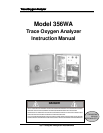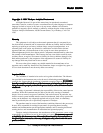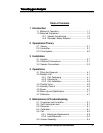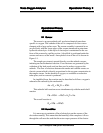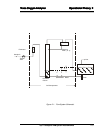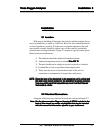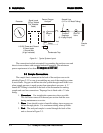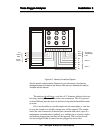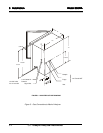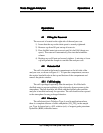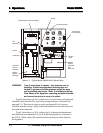
2-1
TT
TT
T
race Oxygrace Oxyg
race Oxygrace Oxyg
race Oxyg
en Analen Anal
en Analen Anal
en Anal
yzyz
yzyz
yz
erer
erer
er
Operational Theory 2Operational Theory 2
Operational Theory 2Operational Theory 2
Operational Theory 2
Teledyne Analytical Instruments
Operational TheoryOperational Theory
Operational TheoryOperational Theory
Operational Theory
2.1 Sensor2.1 Sensor
2.1 Sensor2.1 Sensor
2.1 Sensor
The sensor is an open-cathode cell, an electrochemical transducer
specific to oxygen. The cathode of the cell is composed of silver screen
elements with a large surface area. The screen assembly is mounted in an
acrylic block, with the lower edges of the screens immersed in potassium
hydroxide electrolyte. A thin layer of electrolyte is maintained on the sur-
faces of the screens by capillary action. A lead disk is positioned under the
screens and serves as the anode. An exploded view of the cell is showm in
Figure 5-1.
The sample gas stream is passed directly over the cathode screens,
initiating an electrochemical reaction. Four electrons are generated by the
oxidation of the lead anode, and are then used to reduce oxygen at the
cathode. The flow of electrons between the anode and cathode creates an
electric current which is directly proportional to the oxygen concentration in
the sample stream. In the absence of oxygen, no oxidation or reduction
takes place, and no current is produced.
In simplified form, the reaction may be described as follows: oxygen is
reduced at the cathode by the mechanism
4e
-
+O
2
+ 2H
2
O → 4OH
-
This cathodic half-reaction occurs simultaneously with the anodic half-
reaction
Pb + 2OH
-
→ PbO + H
2
O + 2e
-
The overall reaction is
O
2
+ 2Pb → 2PbO
2.2 Humidifier2.2 Humidifier
2.2 Humidifier2.2 Humidifier
2.2 Humidifier
It is necessary to maintain a film of electrolyte on the screens of the
electrode assembly. This means that the humidity of the sample as it flows
through the cell must be such that the water vapor pressure of the electro-



